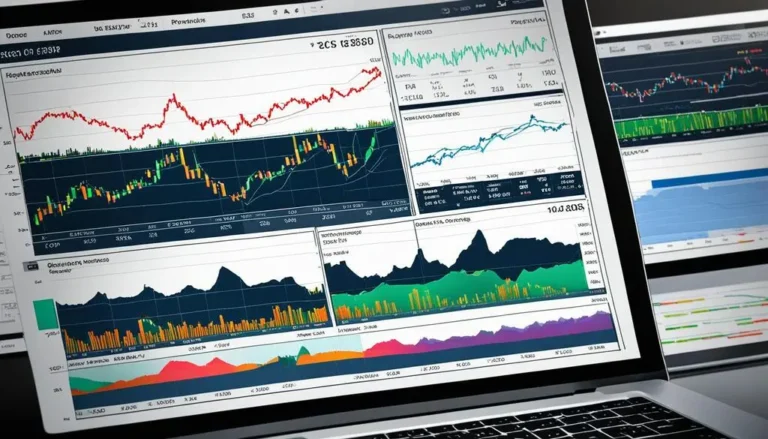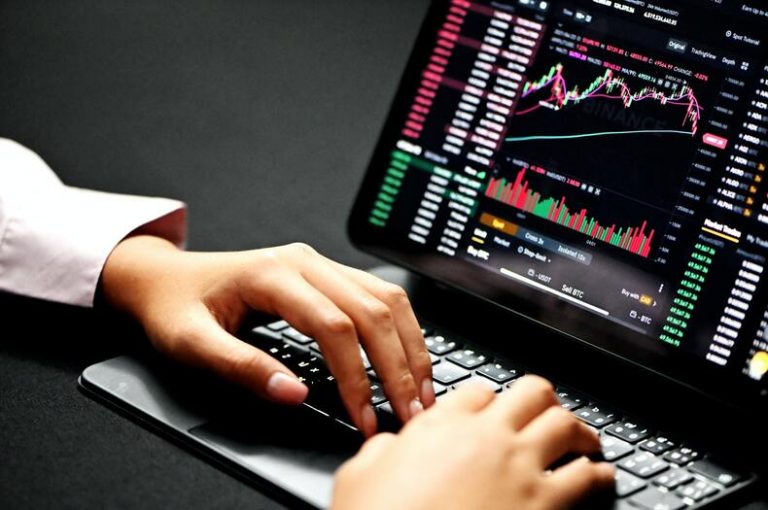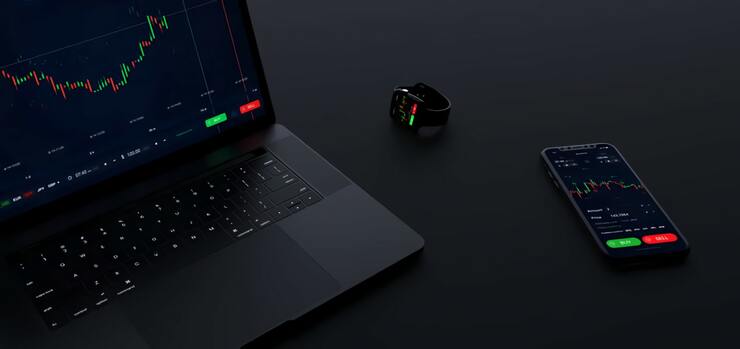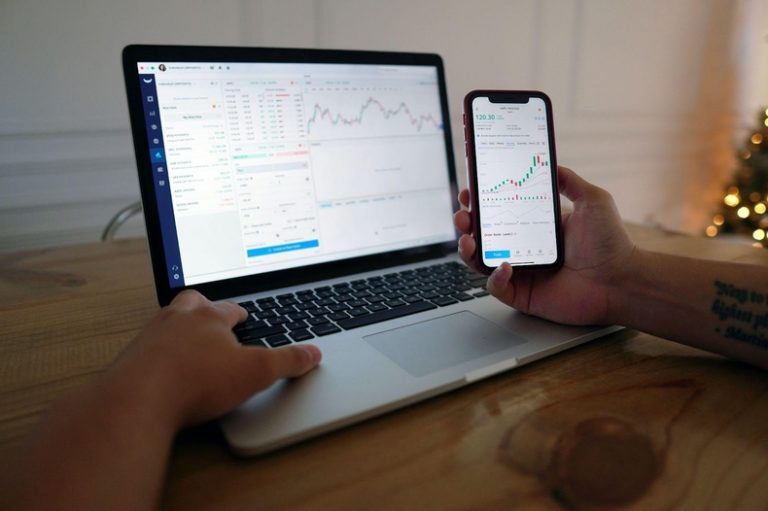Digital Asset Trading Simplified – Get Started Now
Did you know that the cryptocurrency market is worth over $1.5 trillion? That’s right, digital asset trading has become a booming industry with immense potential for investors and traders alike. Whether you’re new to the world of cryptocurrencies or an experienced trader, now is the perfect time to get started and explore the opportunities that digital assets have to offer.

With the rapid growth of cryptocurrencies like Bitcoin and Ethereum, digital asset trading has gained mainstream acceptance and is attracting the attention of investors from all walks of life. But what exactly are cryptocurrencies and how can you get started in this market?
Key Takeaways:
- Digital asset trading is a rapidly growing industry with a market worth over $1.5 trillion.
- Getting started in digital asset trading provides opportunities for investors and traders to explore the potential of cryptocurrencies.
- Cryptocurrencies like Bitcoin and Ethereum are gaining mainstream acceptance and are driving the growth of the digital asset trading market.
- Understanding the basics of cryptocurrencies and choosing the right trading platform is key to starting your digital asset trading journey.
- Stay informed, manage your investments wisely, and be aware of the risks and challenges involved in digital asset trading.
What are Cryptocurrencies?
Cryptocurrencies are digital assets that can be traded and used as a form of payment. They are not overseen or controlled centrally and operate on a decentralized network. Transactions are conducted peer-to-peer using distributed ledger technology, such as blockchain, to record and verify transactions. Cryptocurrencies have no intrinsic value and their worth is determined by supply and demand. There are thousands of cryptocurrencies in existence, with Bitcoin being the largest and most well-known subirimagenes.
The Power of Decentralization
The decentralized nature of cryptocurrencies is one of their key features. Unlike traditional financial systems that rely on central authorities like banks, cryptocurrencies operate on a network of computers spread across the globe. This decentralization ensures that transactions can be conducted directly between users without the need for intermediaries.
“Cryptocurrencies have the potential to revolutionize the financial landscape, offering individuals more control over their money and eliminating the need for traditional banking systems.”
Blockchain Technology
Blockchain technology is at the core of cryptocurrencies. It is a distributed ledger that records and verifies transactions across multiple computers or nodes. Each transaction is grouped into a block and added to a chain of previous blocks, creating an immutable and transparent record of all transactions. This technology ensures the security and integrity of the cryptocurrency network.
The Role of Supply and Demand
The value of cryptocurrencies is primarily determined by supply and demand. As more people buy and hold a particular cryptocurrency, its value tends to increase. Conversely, when there is a sell-off or decreased demand, the value may decrease. Factors such as market sentiment, technological advancements, regulatory developments, and adoption rates also influence the value of cryptocurrencies.
“Cryptocurrency markets can be highly volatile, with prices experiencing significant fluctuations. It is important to understand and manage the risks associated with investing and trading cryptocurrencies.”
A Diverse Universe of Cryptocurrencies
The world of cryptocurrencies is vast and diverse. While Bitcoin remains the most well-known cryptocurrency, there are thousands of other cryptocurrencies available. Each cryptocurrency aims to solve different problems and offers unique features. Some cryptocurrencies focus on privacy, while others prioritize scalability or smart contract capabilities. Research and understanding the fundamentals of each cryptocurrency are essential before making investment or trading decisions.
Risks and Challenges of Digital Asset Trading
Digital asset trading presents various risks and challenges that traders need to be aware of. These factors can significantly impact trading outcomes and should be carefully considered before engaging in this market.
Market Volatility: The digital asset trading market is highly volatile, with prices experiencing rapid fluctuations. This volatility can lead to both substantial gains and losses within short periods. Traders should be prepared for sudden price movements and understand the potential impact on their investments.
Risk of Scams and Fraud: The cryptocurrency space is unfortunately associated with scams and fraudulent activities. Traders may encounter fake exchanges, Ponzi schemes, and other malicious actors seeking to exploit unsuspecting individuals. It is crucial to thoroughly research and verify the credibility of any platform or investment opportunity before getting involved.
Difficulties in Valuation: Unlike traditional assets, the value of cryptocurrencies can be challenging to predict and accurately assess. Factors such as network adoption, technological advancements, regulatory developments, and market sentiment can all influence the value of digital assets. Traders must stay informed and utilize analytical tools to evaluate the potential worth of their investments.
Regulatory Concerns: Regulatory authorities, including the Financial Conduct Authority (FCA), have expressed concerns regarding the risks associated with cryptoassets. They have raised issues such as consumer protection, market manipulation, and money laundering. Traders should be aware of the evolving regulatory landscape and comply with relevant regulations to mitigate potential risks.
Overall, digital asset trading offers significant opportunities for profit and growth, but it also comes with inherent risks and challenges. Traders should educate themselves, exercise caution, and implement risk management strategies to navigate the dynamic nature of this market.
Example Table: Comparison of Risks in Digital Asset Trading
| Risks | Description |
| Market Volatility | The market is highly volatile with frequent and significant price fluctuations. |
| Risk of Scams and Fraud | There is a risk of encountering scams and fraudulent activities in the cryptocurrency space. |
| Difficulties in Valuation | The value of cryptocurrencies can be challenging to predict and accurately assess. |
| Regulatory Concerns | Regulatory authorities have expressed concerns about the potential risks associated with cryptoassets. |
How to Get Started with Digital Asset Trading?
To embark on your digital asset trading journey, follow these steps:
- Choose a reputable trading platform or exchange that supports digital asset trading. Platforms like Revolut offer a user-friendly interface and the ability to invest in popular cryptocurrencies like Bitcoin and Ethereum.
- Decide which cryptocurrency you want to trade. Conduct thorough research on the cryptocurrency’s fundamentals, market trends, and historical price performance. This will help you make informed trading decisions.
- Start with established cryptocurrencies like Bitcoin. These are more stable and widely accepted, making them ideal for beginners. As you gain experience and confidence, you can gradually expand your portfolio to include other cryptocurrencies.
- Stay informed about the latest news and developments in the crypto market. Sign up for newsletters, follow reputable sources, and join online communities to stay updated.
- Set up a secure digital wallet to store your digital assets. A wallet is essential for safely storing and accessing your cryptocurrencies. Research different wallet options and choose one that offers strong security features.
- Beware of potential scams and fraudulent activities in the crypto space. Be cautious of unsolicited investment advice and always verify the legitimacy of any platform or investment opportunity before making a decision.
Getting started with digital asset trading may seem daunting at first, but with the right platform, research, and precautions, you can navigate the exciting world of cryptocurrencies and potentially reap significant rewards.
Strategies for Digital Asset Trading
When it comes to digital asset trading, having a well-defined strategy can greatly improve your chances of success. Let’s explore some popular strategies that can help you navigate the volatile market and make informed trading decisions.
Read also: MYOLSD Login – Olentangy Local School District By ClassLink – my.olsd.us
Dollar Cost Averaging (DCA)
Dollar-cost averaging is a strategy where you divide your investment into smaller amounts and buy at regular intervals, regardless of the current price. This approach helps reduce the impact of market volatility and allows you to accumulate more assets during market downturns. With DCA, you can take advantage of lower prices and potentially benefit from long-term gains.
The Golden Cross/Death Cross
The golden cross and death cross strategies involve using moving averages to identify trends and make buy or sell decisions. The golden cross occurs when a short-term moving average crosses above a long-term moving average, indicating a bullish trend. On the other hand, the death cross happens when a short-term moving average crosses below a long-term moving average, signaling a bearish trend. By analyzing these moving average crossovers, traders can make timely decisions based on market trends.
RSI Divergence Strategy
The RSI divergence strategy focuses on discrepancies between the price of an asset and the Relative Strength Index (RSI). The RSI is a momentum indicator that measures the speed and change of price movements. When the price and the RSI show contrasting signals, such as the price making higher highs while the RSI makes lower highs, it may indicate a potential trend reversal. Traders can use this strategy to identify entry or exit points in the market.
Remember, these strategies are not foolproof and do not guarantee profits. The digital asset market can be highly volatile, and it’s important to conduct thorough research, stay informed about market trends, and use risk management techniques. Consider experimenting with different strategies and adjusting them based on your risk tolerance and trading goals.
By utilizing these strategies and combining them with your knowledge and experience, you can develop a personalized approach to digital asset trading. The key is to stay disciplined, adapt to market conditions, and always evaluate the potential risks and rewards.
| Strategy | Description |
| Dollar Cost Averaging (DCA) | Divide your investment into smaller amounts and buy at regular intervals, reducing the impact of market volatility. |
| The Golden Cross/Death Cross | Use moving averages to identify trends and make buy or sell decisions based on crossovers. |
| RSI Divergence Strategy | Look for discrepancies between price and the Relative Strength Index (RSI) to predict potential trend reversals. |
Implementing the right strategy can make a significant difference in your digital asset trading journey. Remember to stay informed, stay disciplined, and continuously evaluate and refine your approach. Happy trading!
Choosing the Right Trading Platform
When it comes to digital asset trading, selecting the right trading platform is crucial. The platform you choose can greatly impact your trading experience and ultimately determine your success in the market. Here are some key factors to consider when making your decision:
- Security: The security of your digital assets should be a top priority. Look for platforms that implement robust security measures, such as two-factor authentication (2FA) and encryption, to protect your funds from potential threats.
- Reputation: It’s important to choose a platform with a good reputation in the industry. Research user reviews, ratings, and feedback to gauge the platform’s reliability and trustworthiness.
- Fees: Trading platforms often charge fees for transactions and other services. Consider the fee structure of different platforms and compare them to find the most cost-effective option for your trading needs.
- Available Cryptocurrencies: Depending on your trading preferences, you’ll want to ensure that the platform supports the cryptocurrencies you wish to trade. Check the platform’s list of available cryptocurrencies and the variety of trading pairs offered.
- User Interface: A user-friendly interface can make a significant difference in your trading experience. Look for platforms that offer intuitive navigation, customizable charts, and real-time market data to help you make informed trading decisions.
- Customer Support: In case you encounter any issues or have questions, reliable customer support is essential. Choose a platform that offers prompt and responsive customer support through various channels, such as live chat, email, or phone.
Popular trading platforms that meet these criteria include Revolut, Binance, and Coinbase. However, it’s always recommended to do your own research and compare different platforms before making a final decision. Each platform has its own strengths and weaknesses, so consider your personal preferences and trading goals.
Remember, finding the right trading platform is a crucial step towards your digital asset trading journey. Take the time to evaluate your options, choose a platform that aligns with your needs, and start exploring the world of cryptocurrencies with confidence and security.
Managing Investments and Maximizing Returns
When it comes to digital asset management, careful planning and strategy are key to maximizing returns. Diversifying your portfolio is crucial in order to reduce risk and take advantage of different investment opportunities. This includes not only investing in various cryptocurrencies but also considering other asset classes.
Staying on top of market trends and monitoring your investments is essential to making informed decisions. By keeping a close eye on the performance of your assets, you can make adjustments as needed to capitalize on potential growth and mitigate losses.
One effective tool for managing your digital assets is a portfolio tracker. These platforms provide a comprehensive view of your investments, allowing you to track their performance, set goals, and analyze trends. They can also help you make informed decisions by providing real-time market data and insights.
Additionally, staying updated with news and developments in the cryptocurrency market is crucial for making better investment decisions. Being aware of industry trends, regulatory changes, and emerging technologies can give you a competitive edge and help you identify promising investment opportunities.
“Diversifying your portfolio is like capturing different colors on a canvas. It not only reduces risk but also allows for the potential of unique returns.”
By incorporating these strategies and tools into your investment approach, you can effectively manage your digital assets and create opportunities to maximize returns.
Advantages and Disadvantages of Digital Asset Management
It’s important to weigh the advantages and disadvantages of digital asset management before diving into the market.
| Advantages | Disadvantages |
| Potential for high returnsAccessibility to global marketsOpportunities for diversificationTransparent transactions | High market volatilityRegulatory risksSecurity concernsPotential for scams |
By analyzing the advantages and disadvantages, you can make an informed decision about whether digital asset management is right for you. It’s important to consider your risk tolerance, financial goals, and level of knowledge in the market.
Common Mistakes to Avoid in Digital Asset Trading
When it comes to digital asset trading, there are several common mistakes that traders should be aware of and avoid. By understanding and learning from these mistakes, you can improve your trading strategy and increase your chances of success in this dynamic market.
Investing more than you can afford to lose
One of the biggest mistakes that traders make is investing more money than they can afford to lose. Digital asset trading, especially in cryptocurrencies, can be highly volatile, and prices can fluctuate dramatically. It’s essential to set a budget and only invest funds that you are comfortable losing. Avoid taking on excessive risk and maintain a disciplined approach to money management.
Not conducting thorough research
Another common mistake is failing to conduct thorough research before making trading decisions. It’s crucial to have a deep understanding of the digital assets you are trading, including their underlying technology, market trends, and historical performance. By conducting thorough research, you can make more informed trading decisions and avoid making impulsive or uninformed choices.
Following hype and FOMO (fear of missing out)
Trading based on hype and FOMO (fear of missing out) can lead to poor decision-making and unnecessary risks. It’s important to avoid jumping into trades or investing in digital assets solely because of the hype surrounding them. Instead, focus on long-term strategies, thorough analysis, and a rational approach to trading.
Neglecting risk management strategies
Ignoring risk management strategies is another common mistake that traders make. Risk management is essential to protect your capital and minimize potential losses. Implementing stop-loss orders, setting profit targets, and diversifying your portfolio can help mitigate risks and ensure a more balanced approach to trading.
Falling for scams
In the digital asset trading world, scams are unfortunately prevalent. Falling for scams can result in significant financial losses. It’s crucial to be vigilant, educate yourself about common scam tactics, and always verify the credibility and security of the platforms and projects you engage with. Be wary of promises that sound too good to be true and prioritize security in all your trading activities.
To be successful in digital asset trading, approaching it with a disciplined mindset, setting realistic expectations, and learning from both successes and failures is key. Additionally, seeking advice from experienced traders or professionals can provide valuable insights and guidance on navigating the complexities of this market.
Remember, digital asset trading can be both exciting and challenging, but by avoiding these common mistakes, you can improve your trading skills and increase your chances of achieving long-term success.
The Future of Digital Asset Trading
The future of digital asset trading is filled with exciting possibilities and opportunities. Cryptocurrencies have gained significant mainstream acceptance and adoption, indicating a shift in the way we perceive and engage with traditional financial systems.
One of the key drivers of this future trend is the use of blockchain technology and decentralized finance (DeFi). Blockchain technology, the underlying backbone of cryptocurrencies, offers unparalleled security, transparency, and efficiency in financial transactions. DeFi, on the other hand, enables the creation and execution of smart contracts, eliminating the need for intermediaries and empowering individuals to have greater control over their financial assets.
The regulatory landscape surrounding digital asset trading is also evolving to address the challenges and risks associated with cryptoassets. Governments and regulatory authorities are working towards establishing frameworks that protect investors and prevent money laundering and fraud. This increasing regulation is expected to provide a safer and more stable environment for digital asset trading.
Another significant development in the future of digital asset trading is the emergence of central bank digital currencies (CBDCs). CBDCs represent a digital form of fiat currency issued and regulated by central banks. These currencies aim to combine the benefits of cryptocurrencies, such as fast and secure transactions, with the stability and confidence associated with traditional fiat currencies.
Furthermore, institutional participation in digital asset trading is on the rise. Major financial institutions and corporations are recognizing the potential of cryptocurrencies and blockchain technology. They are investing in infrastructure, developing innovative products, and integrating digital assets into their operations. This increased institutional involvement brings credibility and liquidity to the market, further driving the growth of digital asset trading.
Looking ahead, innovation and advancements in technology will continue to shape the future of digital asset trading. We can expect improved user interfaces, enhanced security measures, and greater accessibility to trading platforms. As the technology matures, we may witness the integration of artificial intelligence and machine learning to facilitate more accurate market predictions and efficient trading strategies.
Key Takeaways:
- Cryptocurrencies gaining mainstream acceptance and adoption
- Blockchain technology and DeFi revolutionizing traditional financial systems
- Regulatory frameworks evolving to address challenges and risks
- Development of central bank digital currencies (CBDCs)
- Increased institutional participation in digital asset trading
- Innovation and advancements in technology shaping the future
With these future trends in mind, it is an exciting time to be involved in digital asset trading. As the landscape continues to evolve, staying informed and adapting to the changing dynamics will be key to unlocking the potential of this rapidly growing market.
Expected Future Trends in Digital Asset Trading
| Trend | Description |
| 1. Increased Adoption | More individuals and businesses embracing cryptocurrencies as a form of payment and investment. |
| 2. Enhanced Regulatory Frameworks | Tighter regulations to protect investors and minimize risks associated with digital asset trading. |
| 3. Integration of DeFi | Decentralized finance (DeFi) becoming an integral part of traditional financial systems, offering more accessible and inclusive financial services. |
| 4. Mainstream Acceptance of CBDCs | Central bank digital currencies (CBDCs) gaining widespread acceptance and adoption, transforming the way we transact digitally. |
| 5. Institutional Involvement | Increased participation of financial institutions and corporations in digital asset trading, bringing stability and liquidity to the market. |
| 6. Technological Advancements | Continued innovation in user interfaces, security measures, artificial intelligence, and machine learning to enhance the trading experience. |
Advantages and Disadvantages of Digital Asset Trading
When it comes to digital asset trading, there are both advantages and disadvantages that traders need to consider. Let’s take a closer look at what they are:
Advantages
- Potential High Returns: Digital asset trading can offer the opportunity for significant profits, with some cryptocurrencies experiencing substantial price increases over time.
- Accessibility: Trading platforms and exchanges make it easy for individuals to enter the digital asset market, allowing anyone with an internet connection to participate.
- Global Market Access: Unlike traditional financial markets, digital asset trading operates 24/7 and provides access to a global market, enabling traders to take advantage of opportunities around the clock.
- Transparency: The blockchain technology underlying digital assets allows for transparent and verifiable transactions, providing a level of trust and security.
Disadvantages
- High Market Volatility: The digital asset market is known for its volatility, with prices sometimes experiencing rapid and significant fluctuations. This volatility can result in both substantial gains and losses.
- Regulatory Risks: The regulatory landscape for digital asset trading is still evolving. Traders face the risk of changing regulations that can impact their ability to trade and the overall market stability.
- Security Concerns: As digital assets are stored digitally, there is a risk of security breaches and hacking attempts. It is crucial for traders to take steps to secure their assets and choose reputable platforms or exchanges.
- Potential for Scams: The digital asset space has seen its fair share of scams and fraudulent activities. Traders must be cautious and conduct thorough research to avoid falling victim to scams or investing in illegitimate projects.
While digital asset trading offers opportunities for growth and profit, it also comes with risks and challenges. Traders must carefully weigh the advantages and disadvantages, educate themselves about the market, and make informed decisions to navigate the dynamic world of digital asset trading.
Conclusion
In conclusion, digital asset trading presents a dynamic and evolving market that offers exciting opportunities for growth and investment. Despite the associated risks, it is possible to achieve significant returns by conducting thorough research, implementing effective planning, and embracing risk management strategies. However, it is vital to approach trading with caution, ensuring a solid understanding of the market trends and regulatory landscape.
Educating yourself about digital asset trading is essential to navigate this ever-changing landscape successfully. Staying informed about market trends, new developments, and regulatory changes will help you make informed decisions and mitigate potential risks. Remember, only invest what you can afford to lose, as market volatility is an inherent characteristic of this industry.
As you embark on your digital asset trading journey, consider leveraging the vast potential of cryptocurrencies. Embrace the world of digital assets and explore the myriad of opportunities they offer. By making informed decisions and staying on top of the ever-changing market, you can potentially achieve significant growth and investment success in the exciting realm of digital asset trading.
FAQ
What are cryptocurrencies?
Cryptocurrencies are digital assets that can be traded and used as a form of payment. They operate on a decentralized network and use blockchain technology to record transactions.
What are the risks and challenges of digital asset trading?
Digital asset trading comes with several risks and challenges, including high market volatility, potential scams, and the difficulty of predicting and assessing the value of cryptocurrencies.
How can I get started with digital asset trading?
To get started with digital asset trading, you need to choose a trading platform or exchange, conduct research on the cryptocurrency you want to trade, and set up a secure wallet to store your digital assets.
What are some strategies for digital asset trading?
Some strategies for digital asset trading include dollar cost averaging (DCA), the golden cross/death cross strategy, and the RSI divergence strategy.
How do I choose the right trading platform?
When choosing a trading platform, consider factors such as security, reputation, fees, available cryptocurrencies, user interface, and customer support. Popular platforms include Revolut, Binance, and Coinbase.
How can I manage investments and maximize returns in digital asset trading?
Managing investments in digital assets requires diversification, staying informed about market trends, and adjusting your portfolio accordingly. Tools like portfolio trackers can also help in managing investments.
What are common mistakes to avoid in digital asset trading?
Common mistakes to avoid in digital asset trading include investing more than you can afford to lose, not conducting thorough research, following hype, neglecting risk management strategies, and falling for scams.
What is the future of digital asset trading?
The future of digital asset trading is promising, with cryptocurrencies gaining mainstream acceptance and adoption. The use of blockchain technology and decentralized finance (DeFi) is expected to revolutionize traditional financial systems.
What are the advantages and disadvantages of digital asset trading?
Digital asset trading offers advantages such as potential high returns, accessibility, global market access, and transparency. However, there are also disadvantages, including high market volatility, regulatory risks, security concerns, and the potential for scams.
How can I start my digital asset trading journey?
To start your digital asset trading journey, educate yourself, stay updated with market trends and regulations, make informed decisions, and only invest what you can afford to lose.






